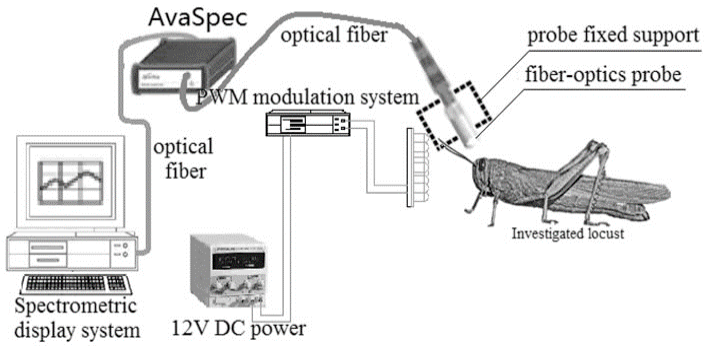Changes in the Visual Response and Thoracic Temperature of Locusta migratoria manilensis Stimulated by LED Spectral Light
Changes in the Visual Response and Thoracic Temperature of Locusta migratoria manilensis Stimulated by LED Spectral Light
QihangLiu1,2, YueliJiang2, Tong Li2, Jin Miao2, Zhongjun Gong2, Yun Duan2, and YuqingWu2*
Device used to investigate the response characteristics of the visual reaction intensity of locusts stimulated by LED spectral light. LED spectral light, supplied by 12V DC adjustable power, was adjusted with PWM modulation system to keep constant. The stimulating intensity (100 lx and 1000 lx of UV, violet, orange light, respectively, and 10000 lx orange light), accept by the visual system of the investigated locust, was obtained through adjusting the supply voltage and the distance between light source and locusts visual system. The same light energy of UV, violet, orange light, stimulating the visual system, was obtained when power supply voltage was 12 V with the same power supply current. When the stimulating time reached, LED light source was closed and Ava Spec fiberoptic spectrometer system was opened immediately to record the response characteristics of the visual reaction intensity.
The device used to measure the changes in the thoracic temperature of locusts in response to spectral light. The above of opaque shielding box (length×width×height: 60 mm×40 mm×60 mm) was opened to place and adjust the investigated locust in box. After making locusts head extend out a Φ10 mm hole in the right side of the box, investigated locust was fixed in the bottom of the box, and the temperature probe of SENDAE thermometer was placed on the thorax through a Φ5 mm hole in the bottom of box. LED light source was supplied by 12 V DC adjustable power to provide different intensity of spectral light stimulation (UV, violet, orange light). The stimulating illumination (100 lx, 1000 lx of UV, violet, orange light, 10000 lx orange light), and the same light energy (for 1500 lx, 2000 lx, 43100 lx of UV, violet, orange light, respectively, corresponding to 12 V supply voltage with the same power supply current), accept by locusts visual system, was obtained through adjusting the supply voltage and the distance between light source and locusts visual system, respectively. The thoracic temperature of locusts in response to spectral light and no spectral light was recorded by SENDAE thermometer.
Visual response of locusts to exposure to UV light for different lengths of time and different intensities (a):100 lx, (b):1000 lx, and (c):1500 lx).
Visual response of locusts to exposure to violet light for different lengths of time and at different intensities (a),100lx; (b),1000 lx; and (c), 2000 lx.
Visual response of locusts to exposure to orange light for different lengths of time and at different intensities. (a): 100 lx orange light; (b): 1000 lx orange light; (c) 10 000 lx violet light; (d): 43 100 lx orange light.
Changes in thoracic temperature induced by exposure to different wavelengths of light at different intensities and for different lengths of time (100 lx, 1000 lx and 1500–43 100 lx). (a): Changes in the thoracic temperature of locusts in response to 100 lx of UV, violet, and orange light for different lengths of time, respectively; (b): Changes in the thoracic temperature of locusts in response to 1000 lx of UV, violet, and orange light for different lengths of time, respectively; (c): Changes in the thoracic temperature of locusts in response to the same light energy (for 1500 lx, 2000 lx, 43100 lx of UV, violet, orange light, respectively) of UV, violet, and orange light for different lengths of time, respectively, and to 10000 lx of orange light for different lengths of time.
















